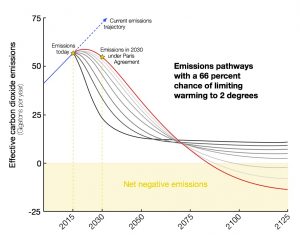27 June 2016
Capping warming at 2 degrees: New study details pathways beyond Paris
Posted by Lauren Lipuma
by Laura Snider

Capping global warming at 2 degrees Celsius (4 degrees Fahrenheit) would likely require net zero greenhouse gas emissions by 2085 and substantial negative emissions over the long term, according to new research. Credit: Karl Frankowski – Flickr.
Even if countries adhere to the Paris climate agreement hammered out last fall, capping global warming at 2 degrees Celsius (4 degrees Fahrenheit) would likely require net zero greenhouse gas emissions by 2085 and substantial negative emissions over the long term, according to an in-depth analysis by scientists at the National Center for Atmospheric Research (NCAR) in Boulder, Colorado.
More than 100 parties to the Paris Agreement submitted pledges to the United Nations Framework Convention on Climate Change outlining their individual commitments to cutting greenhouse gas emissions by 2025 or 2030.
The new study finds that, even if all the countries follow through on their commitments, steeper cuts would be necessary after 2030 to stay below 2 degrees of warming. And by the end of the century, total emissions would need to become negative, meaning more greenhouse gases would be removed from the air than are emitted into the atmosphere.
These negative emissions would need to reach net minus 15 gigatons of “carbon dioxide equivalent,” a measure that tabulates the global warming potential of all types of greenhouse gases in relation to carbon dioxide, according to model simulations created for the study.
Worldwide, yearly greenhouse gas emissions now equal about 50 gigatons of carbon dioxide equivalent.
“The emissions targets in the Paris Agreement are an important first step, and it’s known that additional action will be required to meet the goal of limiting warming to 2 degrees,” said NCAR scientist Benjamin Sanderson, lead author of the study. “This paper provides details of what the next steps would need to look like in order to actually hit that target.”
The new study was published in Geophysical Research Letters, a journal of the American Geophysical Union.

This graph represents eight possible pathways that society could take to have a two-in-three chance of limiting warming to 2 degrees Celsius. The blue line represents our current emissions trajectory. The red line represents the path that society will be on if countries adhere to the Paris Agreement. The gray lines represent other possibilities, all of which require more stringent emissions cuts in the near term but fewer negative emissions later.
Credit: NCAR/UCAR.
Small changes now equal big benefits later
Even before the Paris agreement was finished, it was clear that the pledged emissions cuts by 2030 would not be sufficient on their own to meet the target of limiting warming to 2 degrees. This study gives a comprehensive look at the possible paths society could take to have a two-in-three chance of staying below the target.
“We created a wide range of possible global emissions pathways that would allow us to have a decent shot at limiting warming to two degrees,” Sanderson said. “We found that very small increases in the rate at which we cut greenhouse gases now could lead to very large decreases in the amount of negative emissions we need later.”
Negative emissions in the future will require the massive deployment of technologies that are still hypothetical to draw down greenhouse gases from the atmosphere. That makes it difficult to know how capable society will be to implement large-scale carbon removal in the future.
Sanderson and colleagues also found that it is still possible to stay below 2 degrees of warming without net negative emissions, but to do so would require near-term cuts that are much more aggressive than those proposed in the Paris agreement.
— Laura Snider is a Senior Science Writer at NCAR. This post originally appeared as a news release on the NCAR website.


 GeoSpace is a blog on Earth and space science, managed by AGU’s Public Information staff. The blog features posts by AGU writers and guest contributors on all sorts of relevant science topics, but with a focus on new research and geo and space sciences-related stories that are currently in the news.
GeoSpace is a blog on Earth and space science, managed by AGU’s Public Information staff. The blog features posts by AGU writers and guest contributors on all sorts of relevant science topics, but with a focus on new research and geo and space sciences-related stories that are currently in the news.